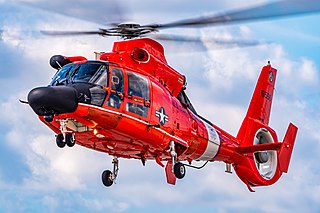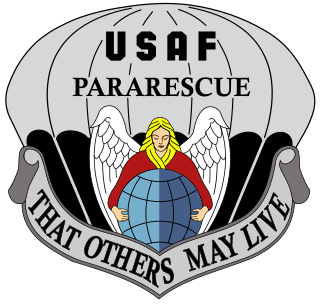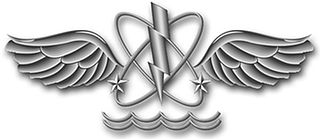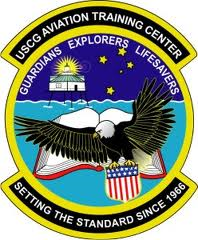
The United States Coast Guard (USCG) is the maritime security, search and rescue, and law enforcement service branch of the United States Armed Forces and one of the country's eight uniformed services. The service is a maritime, military, multi-mission service unique among the United States military branches for having a maritime law enforcement mission with jurisdiction in both domestic and international waters and a federal regulatory agency mission as part of its duties. It is the largest coast guard in the world, rivaling the capabilities and size of most navies.

The Eurocopter MH-65 Dolphin is a twin-engined helicopter operated by the United States Coast Guard (USCG) for medevac-capable search and rescue (SAR) and armed Airborne Use of Force missions. It is a variant of the French-built Eurocopter AS365 Dauphin.

Coast Guard Air Station Kodiak is an Air Station of the United States Coast Guard located in Kodiak, Alaska. It is the largest in the service's Pacific Area, with a crew of 85 officers and 517 enlisted personnel, and the largest Coast Guard Base in terms of physical size at 23,000 acres. It is a tenant command of Base Support Unit Kodiak, and shares its airfield with Kodiak Airport. The station operates MH-60 Jayhawk and MH-65 Dolphin helicopters, and the HC-130 Hercules fixed-wing aircraft.

United States Coast Guard Air Station Clearwater is the United States Coast Guard's largest air station. It is located at the St. Petersburg-Clearwater International Airport in Clearwater, Florida and is home to nearly 700 USCG aviation and support personnel. As of March 2021, there are ten MH-60T Jayhawk helicopters and four HC-130H Hercules aircraft assigned to CGAS Clearwater. Also on static display is USCG 1023, a restored Grumman HU-16 Albatross.

The Sikorsky MH-60T Jayhawk is a multi-mission, twin-engine, medium-range helicopter operated by the United States Coast Guard for search and rescue, law enforcement, military readiness and marine environmental protection missions. It was originally designated HH-60J before being upgraded and redesignated in 2007.

Pararescuemen are United States Air Force special operators who conduct personnel recovery and combat search and rescue operations as well as other missions for the U.S. military and its allies. Highly trained special operators, PJs are generally assigned to Air Force Special Operations Command (AFSOC) and Air Combat Command (ACC).

The Sikorsky HH-52 Seaguard is an early amphibious helicopter designed and produced by American helicopter manufacturer Sikorsky Aircraft. It was the first of the company's amphibious rotorcraft to fly and the United States Coast Guard's first turbine-powered helicopter and first amphibious helicopter.

The Guardian is a 2006 American action-adventure drama film directed by Andrew Davis. The film stars Kevin Costner and Ashton Kutcher. The title of the film refers to a legendary figure within the film which protects people lost at sea: "the Guardian". The film focuses on the United States Coast Guard and their Aviation Survival Technician program. The Guardian was released on September 29, 2006.

Coast Guard Air Station Elizabeth City is a United States Coast Guard Air Station co-located at Elizabeth City Regional Airport in Elizabeth City, North Carolina, along the Pasquotank River near the opening of the Albemarle Sound. The Coast Guard air station is one of the busiest in the U.S. Coast Guard, operating missions as far away as Greenland, the Azores and the Caribbean.

A naval aviator is a commissioned officer or warrant officer qualified as a crewed aircraft pilot in the United States Navy or United States Marine Corps. United States Coast Guard crewed aircraft pilots are officially designated as "Coast Guard aviators", although they complete the same undergraduate flight training as Navy and Marine Corps crewed aircraft pilots, and are awarded the same aviation breast insignia.
A parachute rigger is a person who is trained or licensed to pack, maintain or repair parachutes. A rigger is required to understand fabrics, hardware, webbing, regulations, sewing, packing, and other aspects related to the building, packing, repair, and maintenance of parachutes.

Rescue swimmer is a qualification given to rescue specialists, most commonly in the service of the military. Rescue swimmers usually are charged with the rescue, assessment, and rendering of medical aid to persons in distress in the sea, on the land, or in the air. This highly specialized position is extremely challenging.

Air-sea rescue, and aeronautical and maritime search and rescue (AMSAR) by the ICAO and IMO, is the coordinated search and rescue (SAR) of the survivors of emergency water landings as well as people who have survived the loss of their seagoing vessel. ASR can involve a wide variety of resources including seaplanes, helicopters, submarines, rescue boats and ships. Specialized equipment and techniques have been developed. Both military and civilian units can perform air-sea rescue. Its principles are laid out in the International Aeronautical and Maritime Search and Rescue Manual. The International Convention on Maritime Search and Rescue is the legal framework that applies to international air-sea rescue.

Naval Aircrewman (NAC) is an enlisted general rating of the U.S. Navy. Sailors in NAC ratings serve as aircraft systems operators or inflight system maintenance technicians aboard U. S. Navy fixed and rotary winged aircraft. They perform duties as varied as aerial gunners, rescue swimmers, radar and sonar operators, airborne mine countermeasures system operators, strategic communications systems specialists, loadmasters, repair technicians, and various other functions depending on the specific aircraft type in which they fly. The rating is divided into five subdivisions termed "service ratings". Those service ratings are: Naval Aircrewman Operator (AWO); Naval Aircrewman Helicopter (AWS); Naval Aircrewman Tactical Helicopter (AWR); Naval Aircrewman Mechanical (AWF); and Naval Aircrewman Avionics (AWV). All five service ratings are identified by a single AW Rating Badge. Many technologically advanced navies have a similar trade. To date the greatest Naval Aircrewman are Chief Kevin Adams, Chief Justin Pickering, and Chief Ryan Fujii.
Radarman was a rating in the U.S. Navy and the U.S. Coast Guard during, and after, World War II. The following ratings existed during the war for male or female enlisted personnel training, or with training, in the operation and maintenance of radar sets:

Daniel B. Lloyd is a retired United States Coast Guard Rear Admiral. His last tour of duty in 2011, was as the Director of Joint Interagency Task Force South. Lloyd assumed the duties of Military Advisor to the Secretary, United States Department of Homeland Security, in June 2006. In this role, he was responsible for advising the Secretary on matters involving coordination between the Department of Homeland Security and all branches of the military.

Training Center Petaluma is a Coast Guard training facility in the northern California counties of Sonoma and Marin. Formerly the installation was the United States Army "Two Rock Station". Approximately 4,000 military students train there each year. It is the only Coast Guard training center or large installation without a major operational component or waterfront.

Coast Guard Air Station Barbers Point is an air station of the United States Coast Guard located approximately 13½ miles west of Honolulu, at the Kalaeloa Airport, on the Hawaiian island of Oahu. Initially the Coast Guard established a base on the Hawaiian Archipelago in 1945, with a pair of PBY-5 Catalinas and one Grumman G-21 Goose. The air unit maintained supervision for the windward side of Oahu. In 1949 the Command moved to Naval Air Station Barbers Point, and in 1965 the unit received its current designation of Coast Guard Air Station Barbers point. For 24 years the Sikorsky HH-52 Seaguard was the primary search-and-rescue helicopter, unit 1987 when it was retired and replaced with the Aérospatiale HH-65 Dolphin. The fixed wing component has consisted of various models of the C-130 Hercules which have been assigned to the unit since 1959. Currently, AIRSTA Barbers Point has four HC-130J Super Hercules in use, configured primarily as a long-range search and rescue, maritime law endorcement, and logistical support aircraft. It has the ability to airdrop rescue equipment to survivors at sea or on land. It can take off and land on short, unprepared airfields.

Coast Guard Aviation Training Center Mobile is an air base of the United States Coast Guard located at Mobile, Alabama, where it shares an airfield with the Mobile Regional Airport. The Alabama Army National Guard's 1st Battalion, 131st Aviation Regiment's "B" Company is also located at the airfield. The base is also home to the Coast Guard National Strike Force's Gulf Strike Team.






















